THE DE LAUNE CYCLING CLUB ROLL OF HONOUR

1939 - 1945
|
Introduction
I was asked by Mr Brian Saxton to
compile, from the names on the De Laune Cycling Club's War Memorial, a
book of remembrance dedicated to those Service Men of the Club who were
killed in the two World Wars. Information has been sought from War
Office and Air Ministry records, Battalion Histories, The Office Of
Births, Deaths and Marriages and not least from the "Budgets".
I have included many of the reports, particularly on the aircrew, as
they were written the following day.
It has not been possible, in some
cases, to identify exactly what happened to individuals, so I have had
to content myself with overall Battalion/Squadron actions on the day in
question. But overall I feel that the information contained in the
following pages gives an insight into the operations and actions that
involved these courageous men.
Mark Smith
OMRS WFA
September 1993 |
| Sergeant B. W.
PALASTANGA RCAF
Name: Bernard William PALASTANGA
Born: Southam - 4 July 1920
Lived: N/K
Service: Royal Canadian Air Force
Squadron: 408 Squadron RCAF - Bomber Command
Trade: Observer
Service No: 933248
Rank: Sergeant
Son of: William Joseph & Dora Palastanga of
Hollington St. Leonards-on-Sea Sussex
Missing Believed Killed: 7 November 1941 - Age 21
Buried: Hindeloopen Protestant Church Yard - Plot
B Row 13 Grave 5 |
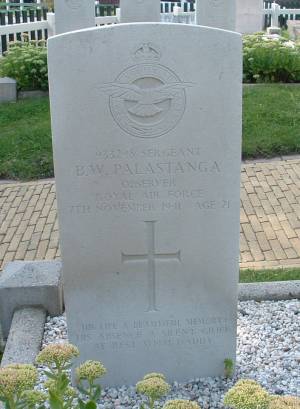
Photo by Rob van Voorst
Please also see Stevin Oudshoorn's
website
http://www.basher82.nl/Data/Hindeloopen/palastanga.htm
|
 On the night of the 6/7 November 1941,
408 RCAF Squadron were operating Hampden Bombers from RAF Syerston. Sgt.
Palastanga was the Observer in Hampden AD 972 which took off as part of
a raid on Germany (Target not identified). As they were crossing the
Dutch coast returning from bombing the target, Hampden AD 972 was
attacked by a Messerschmitt 110 night fighter. The aircraft was
immediately put into a diving cork-screw to port manoeuvre and contact
was lost with the enemy aircraft but not before it had fired several
bursts of machine gun and cannon fire. A crew check was made by the
pilot to which Sgt. Palastanga did not respond. On checking his position
the escape hatch was found open. Sgt. Palastanga had evidently bailed
out as his stowed parachute was missing from the rack.
Sgt. Palastanga was reported as missing - believed
killed in action.
Attached to the above report is a telegram from
the International Red Cross reporting that the body of Sgt Palastanga
was washed ashore on 12 April 1942.
A report from a German file found in 1947 states
that the body of Sgt. Palastanga was buried in Grave 5 Row 13 Section B
of Hindeloopen cemetery Holland. |
|

 |
| Sergeant R. S.
NEALE RAF
Name: Ronald St.Clair NEALE
Born: 30 June 1914
Lived: N/K
Service: Royal Air Force
Squadron: 50 Squadron - Bomber Command
Trade: Wireless Operator/Air Gunner
Service No: 1275564
Rank: Sergeant
Killed: 15 November 1941 - Age 27
Buried: The Commonwealth War Graves Commission
have No Trace of Sgt. Neale's burial. |
 |
| On the night of the 14/15 November 1941, 50
Squadron were operating Hampden Bombers from RAF Swinderby. Sgt. Neale
was the Wop/AG in Hampden P 1152 which took off on the 14 November as
part of a raid on Germany (Target not identified). Whilst over the
target the aircraft was damaged by flak but Sgt Young, the pilot,
managed to coax the damaged bomber home. Whilst they were preparing to
land, the aircraft would not respond to the pilot's attempts to gain
height and crashed on Adiebrowse(?) moor killing Sgt. Young, Sgt. Syms
and Sgt. Neale. Sgt Bemel was rescued from the crashed aircraft but died
of his injuries in Thornaby hospital later that night. |
Sergeant A. P. McGREGOR
RATName: Alexander Percy McGREGOR
Born: London - 23 February 1920
Lived: N/K
Service: Royal Air Force
Squadron: 86 Squadron - Coastal Command
Trade: Wireless Operator
Service No: 917519
Rank: Sergeant
Son Of: Percy Douglas and Florence McGregor of New
Donninigton Shropshire
Missing from Operations 24 November 1941 - Age 21
Commemorated: Panel 47 of the RAF's Runnymede
Memorial To the Missing |
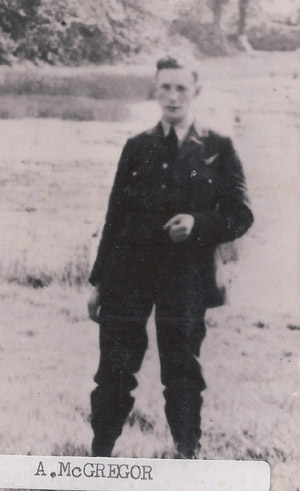 |
| LOST AIRCRAFT REPORT Dated 25 November 1941
Beaufort AW 192 took off for an operational patrol
of the North Sea/Dutch coast. Contact was lost with the aircraft at
16.45 Hrs on the 24 November. It is not clear if they were brought down
by flak or a fighter. Nothing more has been heard of this aircraft.
Pilot Officer Harper
Sgt. Kennedy
Sgt. McGregor
Sgt. Lange - Are All Missing
A message from the German authorities was received
in February 1942 stating that the body of Sgt. Lange was washed ashore
and buried in Schiernowikoog Military cemetery Frisian Island. Grave
number 66.
The rest of the crew are still, as of August 1993,
officially posted as "missing". |
| Gunner R. D.
BRISLEY
Name: Roland Douglas BRISLEY
Born: London S.W. 1920
Lived: London S.W.
Regiment: 138 Field Regiment Royal Artillery
Service No: 998358
Rank: Gunner
Son of: Fred Charles & Lydia Georgina Brisley
of Camberwell London.
Killed in Action: 3 November 1943 - Age 23
Buried: Sangro River War Cemetery Italy - Plot 15
Row E Grave 4 |
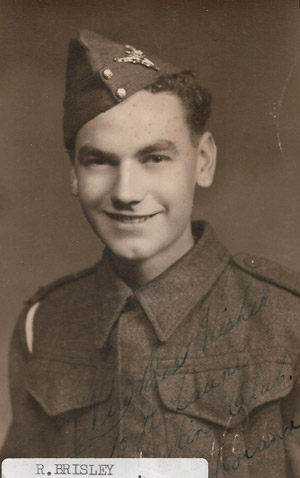 |
| At the time of Gunner Brisley's death 138 Field
Regiment RA were engaged in the battle of the Sangro river. I have been
unable to find any specific detail to their actions that day but from a
letter written to the club at the time it would appear that Gunner
Brisley was a passenger in an Army lorry which hit a land mine killing
the occupants. |
| Pilot OFFICER G.
W. HINDE RAFVR
Name: Geoffrey William HINDE
Born: Manchester - 10 November 1922
Enlisted: 2 April 1941
Lived: London
Service: Royal Air Force Volunteer Reserve
Squadron: 550 Squadron - Bomber Command
Trade: Pilot
Service No: 175573
Rank: Pilot Officer Commissioned 4 May 1944
Son of: Walter and Annie Hinde of Didsbury
Manchester
Killed in Action: 22 May 1944 - Age 21
Buried: Antwerp Schoonfelhof Cemetery Belgium Plot
4A Row E Grave 17 |
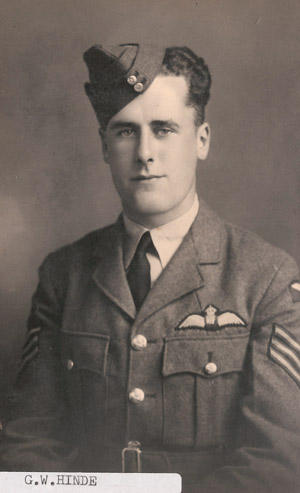 |
| On the night of the 21/22 May 1944,
Lancaster DV 309 piloted by P/Of f. Hinde took off from RAT North
Killingholm with 11 other aircraft from 550 Sqn. to become part of the
main bomber stream for a raid on Duisberg. It would appear that this
Lancaster reached the target but was hit by flak over the target itself.
The actual bomb run was the most dangerous part of any operation as
evasive action could not be taken to enable the bomb aimer the best
possible opportunity to hit the target. An Aiming Point photograph was
taken on a timed delay system to produce a photograph of each bomber's
individual bombs bursting on the target, and these would obviously show
if the aircraft was doing anything other than flying in the prescribed
straight line over the target. The crew:-
P/Of f Hinde
Sgt. Hughes
Sgt. Sharland
Sgt. Whittick
Sgt. Young
Sgt. Beecham
Sgt.
Davies
Were all posted as "Missing believed killed 22 May 1944".
A Telegram from the German Infantry states that
P/Off Hinde was found dead on the morning of the 22 May.
A German file found on the 16 November 1949 shows
that he was buried the next day in the Antwerp Schoonfelhof cemetery
Belgium Plot 4 Part 3 Grave 193.
It is interesting to note that the original RAT
casualty notice showed Geoffrey Hinde as number 1387529 Flight Sergeant
Hinde, his commission to the rank of Pilot Officer on the 4 May 1944
having not yet reached the personnel section. It is unclear whether
Geoffrey knew that he had indeed been commissioned at the time he was
shot down. |
| Sergeant S. C.
EDMONDS
Name: Stanley Charles EDMONDS
Born: London S.E. - 1912
Lived: London
Regiment: 8th Battalion Rifle Brigade
Service No: 6912872
Rank: Sergeant
Son of :William J. & Florrie M. Edmonds of
Rotherhithe London
Killed in Action: 26 June 1944 - Age 32
Buried: St. Manview Cemetery Normandy France Plot
13 Row E Grave 2 |
 |
| Sgt. Edmonds was a regular soldier who
was already serving in the Rifle Brigade at the out-break of the War on
the 3 September 1939. He proceeded with his battalion to North Africa
where he fought in a number of engagements as part of General
Montgomery's 8th Army - The Desert Rats - and had seen a fair share of
action in his time. The 8th Battalion were, at the end of the North
Africa campaign, brought home to England to train for the Invasion of
Europe to be known as Operation Overlord, better known as D Day, to take
place on the 6th June 1944. The 8th Battalion were not involved in the
initial landings but came ashore on D+4, the 10 June 1944. Stan Edmonds
was a Sergeant in F Company and landed on the beach north of Caen at
about 10.3Oam. The Battalion went into a scouting role and were given
Half Track Armoured Personnel Carriers to accomplish this task.
On the morning of the 26th June, F Company, in its
Half Track, was attached to the Fife and Forfar Yeomanry, an armoured
Regiment, to act as infantry support during operation "Epsom"
to capture Hills 112 and 113 and the main road running south - west from
Caen.
They moved forward at first following the 15th
Scottish Division passing through Bretteville L'Orgneielleuse and Cheux,
where dead Canadians showed signs of earlier fighting. As they came out
onto the slopes South of Cheux a battery of German 88mm guns opened up
scoring immediate hits on the tanks of the Yeomen. One shell also made a
direct hit on one of F Company's Half Tracks killing all 10 occupants
including Sgt. Edmonds. |
| Private R. G.
BARNES
Name: Robert George BARNES
Born: London S.W. - 1926
Lived: Birmingham
Regiment: 8th Battalion The Parachute Regiment
Service No: 14640500
Rank: Private
Killed in Action: 24 March 1945 - Age 19
Buried : Reichwald Forest Cemetery Plot 37 Row C
Grave 11 |
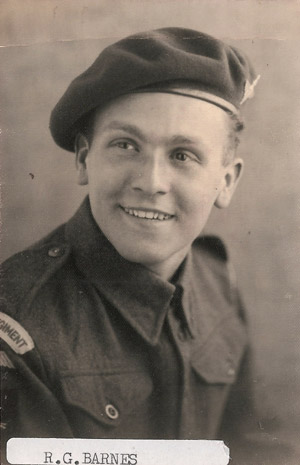 |
OPERATION VARSITY - CROSSING THE RHINE
Before daylight on 24th March 1945 the 6th Airborne Division in 242
Dakotas and 400 gliders took off from their airfields in England and
flew over France and Belgium to the River Rhine. No Pathfinder proceeded
them as the amphibious assault across the river would have started by
the time the aircraft approached the target in daylight, so the pilots
should have had no difficulty in recognising the Dropping Zones (DZ'S)
and Landing Zones (LZ'S). At 9.SOAM, 9 minutes early, 3 Parachute
Brigade started dropping. In 9 minutes the complete brigade was on the
DZ, right on their objective. By the time 40 minutes had elapsed, the
whole 6th Airborne Division had landed on, or very close to, their
objectives. 18 Dakotas were destroyed by flak or were missing; 115 had
flak damage; 35 gliders were destroyed by flak or did not make the LZ's
for technical reasons. And then the battle began. The 8th Battalion was
ordered to clear the woods west of Kopenhof farm. B Company, under Major
Kippen found its Company Rendezvous (RV) held by the remnants of a
Battalion of German parachutists, well dug-in and concealed. There was
no question of organising to attack since it was the RV that was held.
Each individual had to charge towards the position and do the best he
could to kill the enemy. Major Kippen succeeded in getting into an enemy
trench but was instantly killed. Casualties amongst Officers and men
were very high and it was in this charge and subsequent hand-to-hand
fighting that Pte. Barnes was killed. |
| L. BERETTA
& N.B. FARROW
The remaining two names on the Memorial are those
of Leonard Beretta and Norman Farrow. Len Beretta and his
wife were killed in an Air Raid on the 26 September 1940. They were
together in a newly completed shelter at their home when a bomb fell in
the garden next door causing their shelter to collapse. The following is
an extract from the Air Ministry's general air raid report for the 26
September 1940:-
Air Raid Report - London - Thursday 26
September 1940
The main feature of the day's raiding was
increased activity in the provinces. London was under Red Warning twice
during the morning but no major raid developed.
Raids in London eventually commenced at 2030 and
continued until 0300. There was a lull between 0300 and 0500 and raiding
finished at 0450. Enemy activity was again mainly confined to west,
north-west and south-west districts. Extensive damage has been done to
the Houses of Parliament. A UXB (Unexploded Bomb) fell through the
staircase leading to St. Stephen's Hall, and the roof of the India
Office was damaged by blast.
Railway communications have again suffered
severely, the Southern Railway being most affected. LMS lines from St.
Pancras are blocked.
Other damage in the West is not serious, and it is
significant that casualties are small, which may be due to the large
scale evacuation which has taken place.
Royal Small Arms Factory, Enfield, was again
bombed and several fires were started, but quickly got under control, No
serious damage resulted. In the East several fires are reported at
Purfleet, Milwall Dock and West India Docks, but major damage is slight.

Norman Farrow was not
killed on Active Service but died, in 1946, as a result of an illness
contracted whilst in the Army Service Corps stationed throughout the war
years in the MIddle East. Unfortunately as, at the time of his death, he
had been discharged from His Majesty's Forces, I am unable to find in
War Office records any more information than this. |

|
|